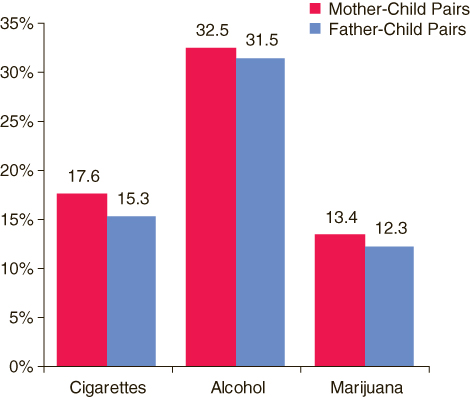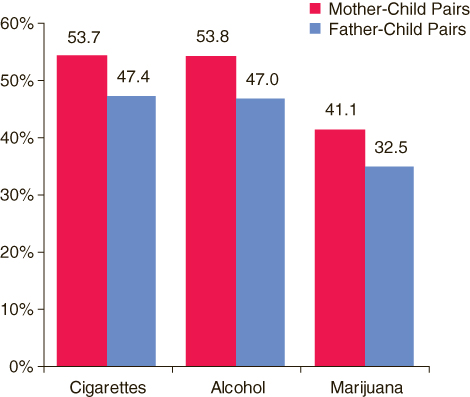
 |
| April 24, 2008 |
|
Combined data from 2002 to 2006 indicate that an annual average of 16.6 percent of youths aged 12 to 17 in parent-child pairs used cigarettes during the past year, 32.1 percent used alcohol, and 12.9 percent used marijuana.8
Rates of past year use of cigarettes, alcohol, and marijuana were similar in mother-child and father-child pairs (Figure 1). In mother-child pairs, 17.6 percent of youths aged 12 to 17 used cigarettes in the past year, 32.5 percent used alcohol, and 13.4 percent used marijuana. In father-child pairs, 15.3 percent of youths used cigarettes, 31.5 percent used alcohol, and 12.3 percent used marijuana.
 |
| Substance | Mother-Child Pairs | Father-Child Pairs |
|---|---|---|
| Cigarettes | 17.6% | 15.3% |
| Alcohol | 32.5% | 31.5% |
| Marijuana | 13.4% | 12.3% |
| Source: SAMHSA, 2002-2006 NSDUHs. |
For both mother-child and father-child pairs, youth substance use in the past year was generally higher within one-parent households than within two-parent households (Table 1). For example, 20.2 percent of youths aged 12 to 17 in mother-child pairs within one-parent households used cigarettes in the past year compared with 16.8 percent of youths in mother-child pairs within two-parent households. Overall, rates of use were highest for all three substances among youths in father-child pairs within one-parent households.
| Substance | Mother-Child Pairs | Father-Child Pairs | ||
|---|---|---|---|---|
| One- Parent Household |
Two- Parent Household |
One- Parent Household |
Two- Parent Household |
|
| Cigarettes | 20.2% | 16.8% | 23.3% | 14.9% |
| Alcohol | 34.5% | 31.9% | 36.6% | 31.2% |
| Marijuana | 16.4% | 12.6% | 18.9% | 11.9% |
| Source: SAMHSA, 2002-2006 NSDUHs. |
Rates of parent awareness of youth cigarette, alcohol, and marijuana use in the past year were generally higher among mothers in mother-child pairs than among fathers in father-child pairs (Figure 2). For example, 41.1 percent of mothers in mother-child pairs with children aged 12 to 17 who used marijuana in the past year were aware of their child's marijuana use compared with 32.5 percent of fathers in comparable father-child pairs.
 |
| Substance | Mother-Child Pairs | Father-Child Pairs |
|---|---|---|
| Cigarettes | 53.7% | 47.4% |
| Alcohol | 53.8% | 47.0% |
| Marijuana | 41.1% | 32.5% |
| Source: SAMHSA, 2002-2006 NSDUHs. |
Parent awareness of adolescents' use of cigarettes and alcohol in the past year increased with the youth's increasing age among both mother-child and father-child pairs (Table 2). For example, 33.4 percent of mothers in mother-child pairs with children aged 12 to 14 who used alcohol in the past year were aware of their child's alcohol use. In comparison, 60.5 percent of mothers with children aged 15 to 17 who used alcohol in the past year were aware of their child's alcohol use. The percentage of parents who were aware of their child's marijuana use was relatively consistent regardless of the age of the youth.
| Substance | Mother-Child Pairs | Father-Child Pairs | ||
|---|---|---|---|---|
| 12 to 14 | 15 to 17 | 12 to 14 | 15 to 17 | |
| Cigarettes | 42.3% | 57.3% | 35.2% | 51.1% |
| Alcohol | 33.4% | 60.5% | 29.2% | 53.4% |
| Marijuana | 40.8% | 41.2% | 34.5% | 32.1% |
| Source: SAMHSA, 2002-2006 NSDUHs. |
Mothers in mother-child pairs within one-parent households generally had the highest rates of awareness of their child's past year substance use, followed by mothers in mother-child pairs within two-parent households, and then fathers in father-child pairs within two-parent households (Table 3).9 For example, 61.4 percent of mothers in mother-child pairs within one-parent households were aware of their child's past year cigarette use compared with 51.0 percent of mothers in mother-child pairs within two-parent households and 47.3 percent of fathers in father-child pairs within two-parent households.
| Substance | Mother-Child Pairs | Father-Child Pairs | ||
|---|---|---|---|---|
| One- Parent Household |
Two- Parent Household |
One- Parent Household |
Two- Parent Household |
|
| Cigarettes | 61.4% | 51.0% | *** | 47.3% |
| Alcohol | 53.1% | 54.0% | *** | 46.6% |
| Marijuana | 44.4% | 39.9% | *** | 30.9% |
| Source: SAMHSA, 2002-2006 NSDUHs. |
| The National Survey on Drug Use and Health (NSDUH) is an annual survey sponsored by the Substance Abuse and Mental Health Services Administration (SAMHSA). The 2002 to 2006 data used in this report are based on information obtained from 19,946 parent-child pairs. The survey collects data by administering questionnaires to a representative sample of the population through face-to-face interviews at their place of residence. The NSDUH Report is prepared by the Office of Applied Studies (OAS), SAMHSA, and by RTI International in Research Triangle Park, North Carolina. (RTI International is a trade name of Research Triangle Institute.) Information on NSDUH used in compiling data for this report is available in the following publication: Office of Applied Studies. (2007). Results from the 2006 National Survey on Drug Use and Health: National findings (DHHS Publication No. SMA 07-4293, NSDUH Series H-32). Rockville, MD: Substance Abuse and Mental Health Services Administration. Information for earlier NSDUHs is available in the following publications: 2005 NSDUH: (DHHS Publication No. SMA 06-4194, NSDUH Series H-30) 2004 NSDUH: (DHHS Publication No. SMA 05-4062, NSDUH Series H-28) 2003 NSDUH: (DHHS Publication No. SMA 04-3964, NSDUH Series H-25) 2002 NSDUH: (DHHS Publication No. SMA 03-3836, NSDUH Series H-22) Also available online: http://oas.samhsa.gov. Because of improvements and modifications to the 2002 NSDUH, estimates from the 2002 through 2006 surveys should not be compared with estimates from the 2001 or earlier versions of the survey to examine changes over time. |
| The NSDUH Report is published periodically by the Office of Applied Studies, Substance Abuse and Mental Health Services Administration (SAMHSA). All material appearing in this report is in the public domain and may be reproduced or copied without permission from SAMHSA. Additional copies of this report or other reports from the Office of Applied Studies are available online: http://oas.samhsa.gov. Citation of the source is appreciated. For questions about this report, please e-mail: shortreports@samhsa.hhs.gov.
NSDUH_101 |
|
This page was last updated on December 30, 2008. |
|
SAMHSA, an agency in the Department of Health and Human Services, is the Federal Government's lead agency for improving the quality and availability of substance abuse prevention, addiction treatment, and mental health services in the United States. 
* PDF formatted files require that Adobe Acrobat Reader® program is installed on your computer. Click here to download this FREE software now from Adobe. |